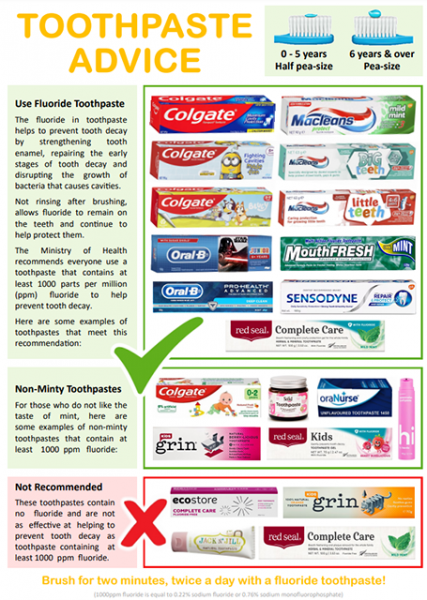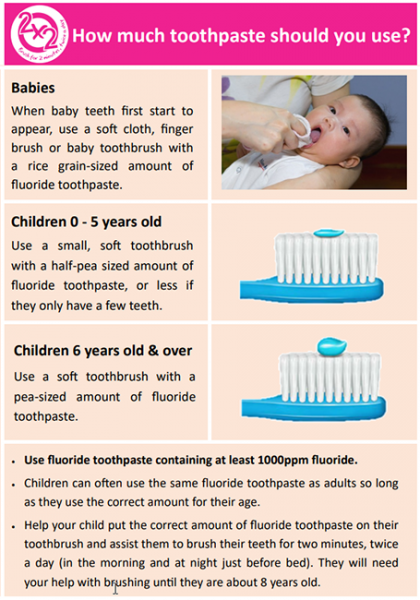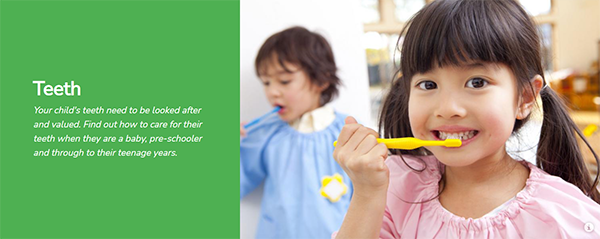Caring For Your Child's Teeth: 1 To 5 Years
Caring For Your Child's Teeth: 1 To 5 Years
Your child will have most of their baby teeth by the age of 2. Find out how you can look after them when they are toddlers and pre-schoolers.
How to look after your child’s teeth
Healthy teeth = a healthy smile.
Follow these 5 steps to protect your child's teeth:
- Brush teeth twice a day with a fluoride toothpaste.
- Have regular dental check-ups.
- Lift the lip every month to check for signs of tooth decay (holes).
- Choose healthy snacks.
- Drink water or milk.
Find out how to care for your baby's teeth
Brush teeth twice a day
By about 3 years of age your child will have their first set of teeth - 20 'baby' teeth. These teeth will help your child eat and speak well. Healthy baby teeth usually mean healthy adult teeth too, so it's important you look after your child's first teeth.
Look after your child's first teeth by brushing them twice a day - after breakfast and before bed. You may find it easier to stand behind your child and gently tilt their head back as you brush. Use a small toothbrush with soft bristles and a half-pea size amount of regular-strength fluoride toothpaste.
Brush your child's teeth for 2 minutes:
- all around the inside surfaces, where the teeth meet the gums, and also the top chewing surfaces
- on the front of the teeth, brushing in tiny circles all around the outside surfaces, close to the gums
Teach your child to spit out the left-over toothpaste after brushing. Don't rinse with water, because a small amount of fluoride toothpaste left around the teeth will help to protect them.
It's important to brush your child's teeth until they are about 8 years old.
Check out which toothpaste to use, which ones to avoid, and how much to use (PDF, 5.5MB).
Regular dental check-ups
Oral healthcare is free for all children until they turn 18. Enrol your child with the service as early as possible, so that you can arrange the first check-up. Regular check-ups of your child's teeth increase the chances of finding and treating any tooth decay (holes) early.
To enrol with a service or to make an appointment, phone 0800 TALK TEETH (0800 825 583). Your dental therapist will tell you how often your child should have a check-up.
If your child accidentally bumps their teeth, take them to your local dentist, even if the teeth still look all right.
Find out more about dental care in New Zealand
Watch this video from Bee Healthy Regional Dental Service on six tips to help with brushing your preschooler's teeth.
Lift the lip
Gently lift your child's top lip once a month to check inside their mouth. It's a quick and easy way to see if tooth decay is present.
You can read about tooth decay and what to look for on the Plunket website.
See the New Zealand Dental Association’s ‘lift the lip’ visual on page 2 (PDF, 1.3MB).
Choose healthy snacks
Healthy eating = healthy teeth. To protect your child's teeth, give them low-sugar snacks between meals such as fruit, fresh vegetables, yoghurt and other dairy foods. Foods that are high in sugar can damage your child's teeth and cause tooth decay.
It’s also important to give teeth a rest during the day, so limit snacks to 2 to 3 times a day.
Check out the visual below on healthy snacks for healthy teeth (PDF, 8.8MB).
See more ideas on healthy snacks from Bee Healthy Regional Dental Service (PDF, 3MB).
Drink water or milk
The best drinks for your child's teeth are water and plain milk. Do not give your child drinks that have natural or added sugar, such as fruit juice, cordial, fizzy drinks, flavoured milks and chocolate drinks. These can cause tooth decay.
Watch this video to find out why your child's first teeth are important and how to care for them. Transcript available at the Ministry of Health website.
Find out how to care for your child’s teeth when they are aged between 5 and 18
See more KidsHealth content on caring for your child's teeth
This page last reviewed 29 April 2022.
Do you have any feedback for KidsHealth?
If you have any feedback about the KidsHealth website, or have a suggestion for new content, please get in touch with us.
Email us now




